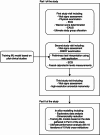Detection of obstetric anal sphincter injuries using machine learning-assisted impedance spectroscopy: a prospective, comparative, multicentre clinical study
- PMID: 40033085
- PMCID: PMC11876446
- DOI: 10.1038/s41598-025-92392-z
Detection of obstetric anal sphincter injuries using machine learning-assisted impedance spectroscopy: a prospective, comparative, multicentre clinical study
Abstract
To evaluate the clinical performance and safety of the ONIRY system for obstetric anal sphincter injuries (OASI) detection versus three-dimensional endoanal ultrasound (EAUS). A prospective, comparative, multicentre, international study. Poland, Czechia, Slovakia, and Spain. 152 women between the first moments up to 8 weeks after vaginal delivery. Participants underwent EAUS and were allocated to groups based on OASIS classification: A (no perineal tear), B (1st or 2nd degree tear), or C (3rd or 4th degree, anal sphincters affected). Electric impedance was measured in the anal canal using the ONIRY system. The primary endpoint was the diagnostic outcome of impedance spectroscopy versus EAUS. Adverse events were collected. Part II involved in silico modelling and 10-time 10-fold cross-validation for automated analysis. Accuracy, sensitivity, and specificity. 30 women were allocated to group A, 61 to group B, and 61 to group C. The diagnostic outcome was determined for 147 participants. The accuracy, sensitivity, and specificity of the ML-assisted impedance spectroscopy were 87.0 ± 0.5%, 90.6 ± 2.0%, and 84.6 ± 1.9%, respectively, compared with EAUS. After data cleaning, the performance metrics of the proposed final ML model for ONIRY were: 90.0 ± 0.4%, 90.0 ± 1.2%, and 90.0 ± 0.7%, respectively. No adverse device effects or deficiencies were observed. By enabling early identification of sphincter injuries, ML-assisted impedance spectroscopy facilitates timely diagnosis and intervention, potentially reducing long-term complications such as faecal incontinence. Its rapid, bedside application in obstetric settings supports immediate postpartum care, complementing digital rectal examination and optimizing clinical decision-making.
Keywords: Anal sphincter; Clinical study; Faecal incontinence; Impedance spectroscopy; Machine learning; Obstetric anal sphincter injury (OASI); Perineal tear; Rapid diagnostics.
© 2025. The Author(s).
Conflict of interest statement
Declarations. Competing interests: K.B. is a founder and board member at OASIS Diagnostics, an author of the related patent and R&D strategy, independent consultant, and trainer of Takeda.M.M., M.R., K.K., and P.I. are researchers at OASIS Diagnostics. A.S. is an independent consultant of Ethicon, Takeda, Pfizer, Sofar. M.UM. is an independent consultant of Regen Lab.H.H., P.J., M.UM., E.D., and E.GD. received remuneration as a study investigator.H.H., C.R., and A.S. are independent consultants and members of the OASIS Diagnostics’ Scientific Advisory Board. Others declare no conflicts of interest. Ethics approval: The study was approved by the ethics committees respective for each study site: on 19 March 2021 by Ethics Committee of the Institute for Maternal and Child Care (no. 1/19.03.2021), on 27 April 2021 by Ethics Committee for Research with Medicines of the Health Areas of León and Bierzo (no. 2186), on 9 June 2021 by Ethics Committee of the University Hospital of Brno (no. 47/21Zdrav.), on 14 October 2021 by Ethics Committee at the Regional Medical Chamber in Warsaw (no. KB/1362/21) and on 25 July 2022 by Ethics Committee at AGEL Hospital Košice-Šaca (no. ONIRY 3/2/2020).
Figures
References
-
- Sideris, M. et al. Risk of obstetric anal sphincter injuries (OASIS) and anal incontinence: A meta-analysis. Eur. J. Obstet. Gynecol. Reproductive Biol.252, 303–312. 10.1016/j.ejogrb.2020.06.048 (2020). - PubMed
-
- Gurol-Urganci, I. et al. Third- and fourth-degree perineal tears among primiparous women in England between 2000 and 2012: Time trends and risk factors. BJOG120(12), 1516–1525. 10.1111/1471-0528.12363 (2013). - PubMed
-
- Dudding, T. C., Vaizey, C. J. & Kamm, M. A. Obstetric anal sphincter injury: Incidence, risk factors, and management. Ann. Surg.247(2), 224–237. 10.1097/SLA.0b013e318142cdf4 (2008). - PubMed
-
- Orlando, A., Thomas, G. & Murphy, J. I Wsp. A systematic review and a meta-analysis on the incidence of obstetric anal sphincter injuries during vaginal delivery. Colorectal Dis.26, 227–242 (2024). - PubMed
-
- Everist, R. et al. Postpartum anal incontinence in women with and without obstetric anal sphincter injuries. Int. Urogynecol. J.31(11), 2269–2275. 10.1007/s00192-020-04267-8 (2020). Epub 2020 Mar 10. - PubMed
Publication types
MeSH terms
Grants and funding
LinkOut - more resources
Full Text Sources
Medical





